 Hold the balloon in your teeth and don't move. I've gone through too many partners this year to lose another one. 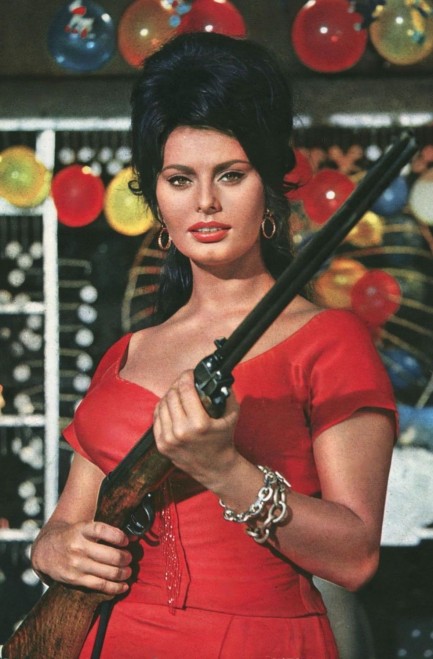
Italian superstar Sophia Loren looks her most beautiful in this promo image made for the 1962 anthology film Boccaccio '70, in which she starred in the Vittorio De Sica-directed segment, “La riffa,” about the owner of a sharpshooting concession at a carnival who consents to be the prize in a lottery. Most agree that of the four segments Loren's was the best, which we're sure comes as no surprise. She's a unique talent. See a few more fun images of her here, here, and here.
 It's shocking how many Hollywood stars did smack. 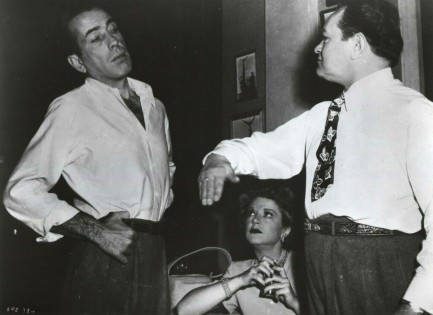
Everybody wants to slap somebody sometime. Luckily, actors in movies do it so you don't have to. The above shot is a good example. Edward G. Robinson lets Humphrey Bogart have it in 1948's Key Largo, as Claire Trevor looks on. In vintage cinema, people were constantly slapping. Men slapped men, men slapped women, women slapped women, and women slapped men. The recipient was usually the protagonist because—though some readers may not realize this—even during the ’40s and 50s, slapping was considered uncouth at a minimum, and downright villainous at worst, particularly when men did it. So generally, bad guys did the slapping, with some exceptions. Glenn Ford slaps Rita Hayworth in Gilda, for example, out of humiliation. Still wrong, but he wasn't the film's villain is our point. Humphrey Bogart lightly slaps Martha Vickers in The Big Sleep to bring her out of a drug stupor. He's like a doctor. Sort of. In any case, most cinematic slapping is fake, and when it wasn't it was done with the consent of the participants (No, really slap me! It'll look more realistic.). There are some famous examples of chipped teeth and bloody noses deriving from the pursuit of realism. We can envision a museum exhibit of photos like these, followed by a lot of conversation around film, social mores, masculinity, and their intersection. We can also envison a conversation around the difference between fantasy and reality. There are some who believe portryals of bad things endorse the same. But movies succeed largely by thrilling, shocking, and scaring audiences, which requires portraying thrilling, shocking, and frightening moments. If actors can't do that, then ultimately movies must become as banal as everyday llife. Enjoy the slapfest.
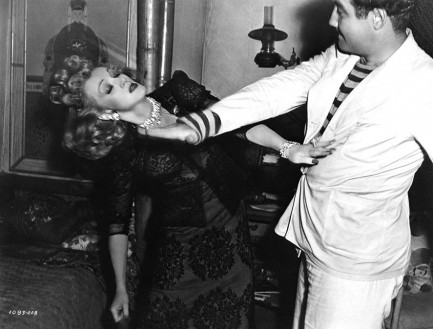 Broderick Crawford slaps Marlene Dietrich in the 1940's Seven Sinners. Broderick Crawford slaps Marlene Dietrich in the 1940's Seven Sinners.
 June Allyson lets Joan Collins have it across the kisser in a promo image for The Opposite Sex, 1956. June Allyson lets Joan Collins have it across the kisser in a promo image for The Opposite Sex, 1956.
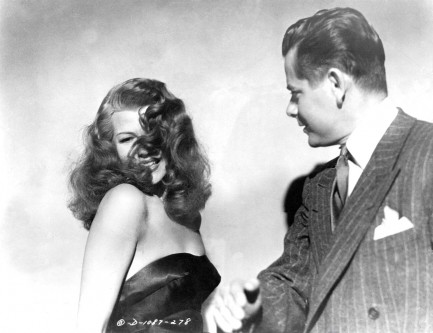 Speaking of Gilda, here's one of Glenn Ford and Rita Hayworth re-enacting the slap heard round the world. Hayworth gets to slap Ford too, and according to some accounts she loosened two of his teeth. We don't know if that's true, but if you watch the sequence it is indeed quite a blow. 100% real. We looked for a photo of it but had no luck. Speaking of Gilda, here's one of Glenn Ford and Rita Hayworth re-enacting the slap heard round the world. Hayworth gets to slap Ford too, and according to some accounts she loosened two of his teeth. We don't know if that's true, but if you watch the sequence it is indeed quite a blow. 100% real. We looked for a photo of it but had no luck.
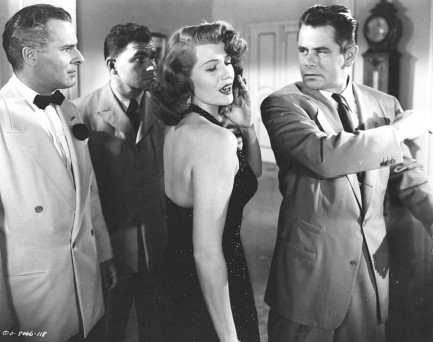 Don't mess with box office success. Ford and Hayworth did it again in 1952's Affair in Trinidad. Don't mess with box office success. Ford and Hayworth did it again in 1952's Affair in Trinidad.
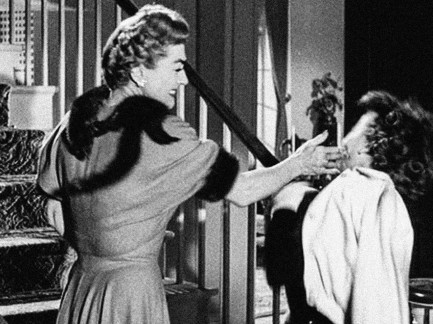 All-time film diva Joan Crawford gets in a good shot on Lucy Marlow in 1955's Queen Bee. All-time film diva Joan Crawford gets in a good shot on Lucy Marlow in 1955's Queen Bee.
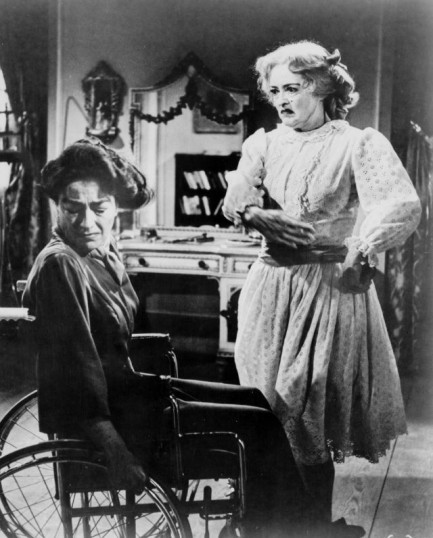 The answer to the forthcoming question is: She turned into a human monster, that's what. Joan Crawford is now on the receiving end, with Bette Davis issuing the slap in Whatever Happened to Baby Jane? Later Davis kicks Crawford, so the slap is just a warm-up. The answer to the forthcoming question is: She turned into a human monster, that's what. Joan Crawford is now on the receiving end, with Bette Davis issuing the slap in Whatever Happened to Baby Jane? Later Davis kicks Crawford, so the slap is just a warm-up.
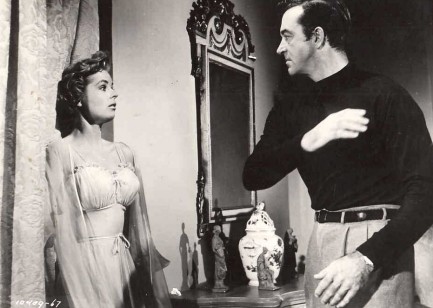 Mary Murphy awaits the inevitable from John Payne in 1955's Hell's Island. Mary Murphy awaits the inevitable from John Payne in 1955's Hell's Island.
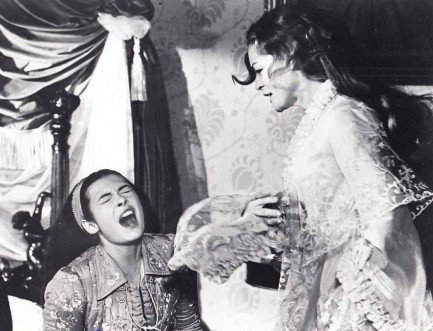 Romy Schneider slaps Sonia Petrova in 1972's Ludwig. Romy Schneider slaps Sonia Petrova in 1972's Ludwig.
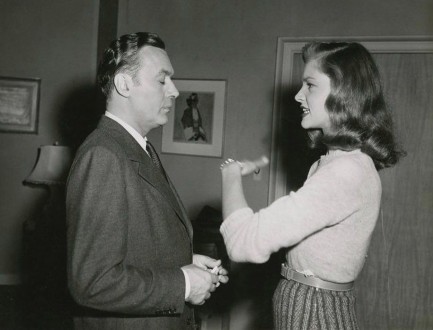 Lauren Bacall lays into Charles Boyer in 1945's Confidential Agent and garnishes the slap with a brilliant snarl. Lauren Bacall lays into Charles Boyer in 1945's Confidential Agent and garnishes the slap with a brilliant snarl.
 Iconic bombshell Marilyn Monroe drops a smart bomb on Cary Grant in the 1952 comedy Monkey Business. Iconic bombshell Marilyn Monroe drops a smart bomb on Cary Grant in the 1952 comedy Monkey Business.
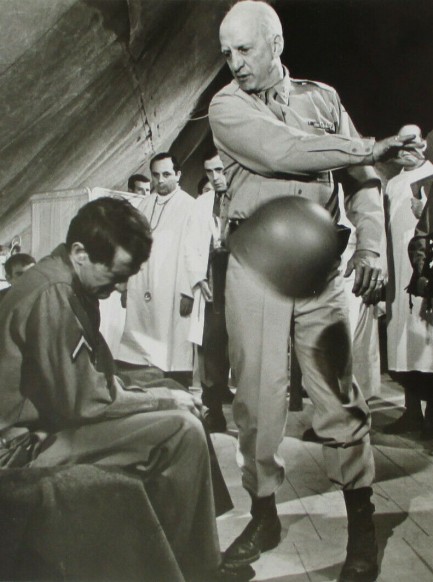 This is the most brutal slap of the bunch, we think, from 1969's Patton, as George C. Scott de-helmets an unfortunate soldier played by Tim Considine. This is the most brutal slap of the bunch, we think, from 1969's Patton, as George C. Scott de-helmets an unfortunate soldier played by Tim Considine.
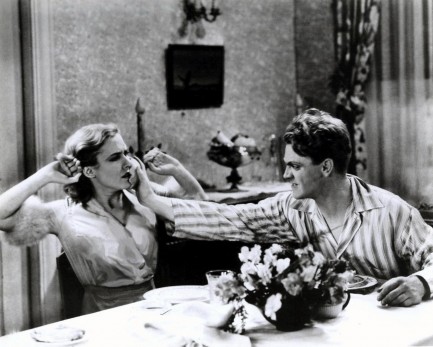 A legendary scene in filmdom is when James Cagney shoves a grapefruit in Mae Clark's face in The Public Enemy. Is it a slap? He does it pretty damn hard, so we think it's close enough. They re-enact that moment here in a promo photo made in 1931. A legendary scene in filmdom is when James Cagney shoves a grapefruit in Mae Clark's face in The Public Enemy. Is it a slap? He does it pretty damn hard, so we think it's close enough. They re-enact that moment here in a promo photo made in 1931.
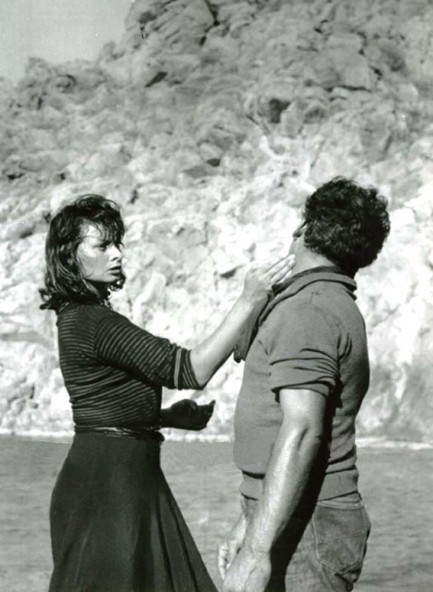 Sophia Loren gives Jorge Mistral a scenic seaside slap in 1957's Boy on a Dolphin. Sophia Loren gives Jorge Mistral a scenic seaside slap in 1957's Boy on a Dolphin.
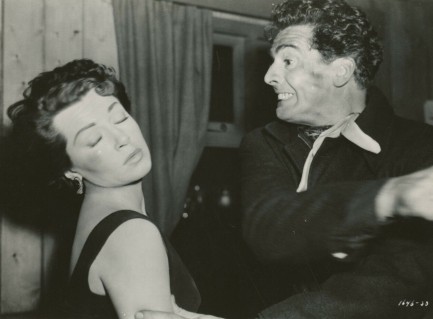 Victor Mature fails to live up to his last name as he slaps Lana Turner in 1954's Betrayed. Victor Mature fails to live up to his last name as he slaps Lana Turner in 1954's Betrayed. 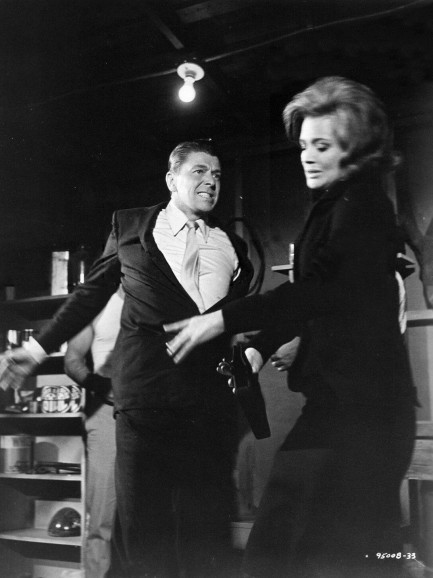 Ronald Reagan teaches Angie Dickinson how supply side economics work in 1964's The Killers. Ronald Reagan teaches Angie Dickinson how supply side economics work in 1964's The Killers.
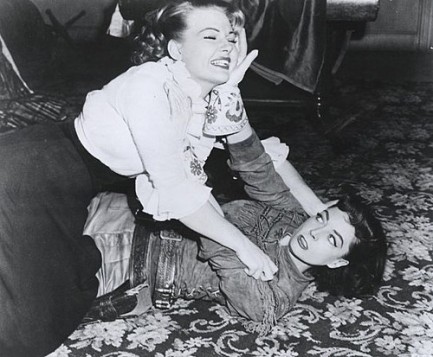 Marie Windsor gets in one against Mary Castle from the guard position in an episode of television's Stories of the Century in 1954. Windsor eventually won this bout with a rear naked choke. Marie Windsor gets in one against Mary Castle from the guard position in an episode of television's Stories of the Century in 1954. Windsor eventually won this bout with a rear naked choke.
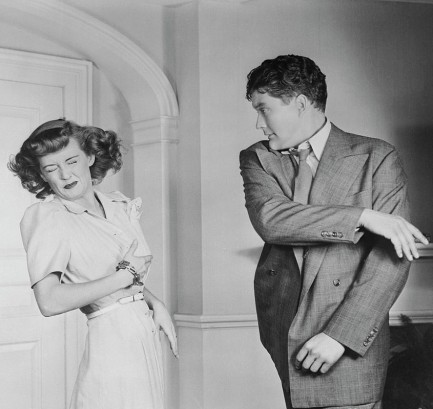 It's better to give than receive, but sadly it's Bette Davis's turn, as she takes one from Dennis Morgan in In This Our Life, 1942. It's better to give than receive, but sadly it's Bette Davis's turn, as she takes one from Dennis Morgan in In This Our Life, 1942.
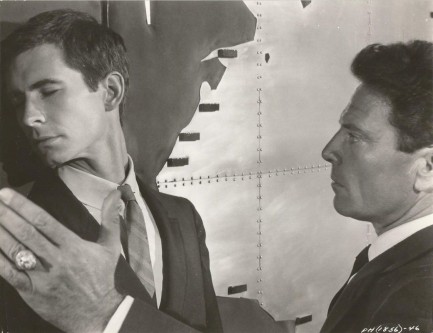 Anthony Perkins and Raf Vallone dance the dance in 1962's Phaedra, with Vallone taking the lead. Anthony Perkins and Raf Vallone dance the dance in 1962's Phaedra, with Vallone taking the lead.
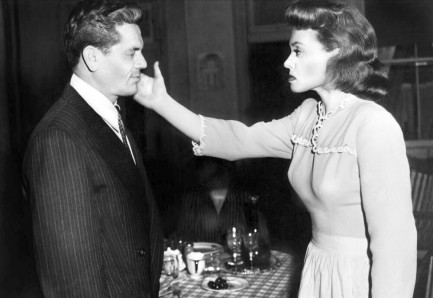 And he thought being inside the ring was hard. Lilli Palmer nails John Garfield with a roundhouse right in the 1947 boxing classic Body and Soul. And he thought being inside the ring was hard. Lilli Palmer nails John Garfield with a roundhouse right in the 1947 boxing classic Body and Soul.
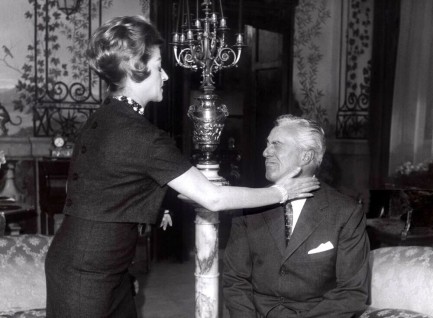 1960's Il vigile, aka The Mayor, sees Vittorio De Sica rebuked by a member of the electorate Lia Zoppelli. She's more than a voter in this—she's also his wife, so you can be sure he deserved it. 1960's Il vigile, aka The Mayor, sees Vittorio De Sica rebuked by a member of the electorate Lia Zoppelli. She's more than a voter in this—she's also his wife, so you can be sure he deserved it.
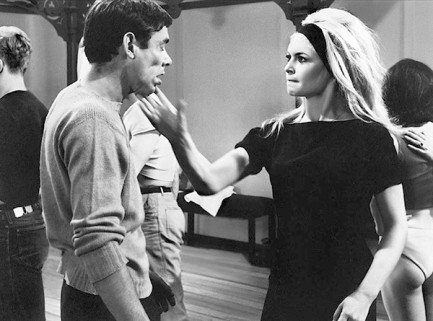 Brigitte Bardot delivers a not-so-private slap to Dirk Sanders in 1962's Vie privée, aka A Very Private Affair. Brigitte Bardot delivers a not-so-private slap to Dirk Sanders in 1962's Vie privée, aka A Very Private Affair.
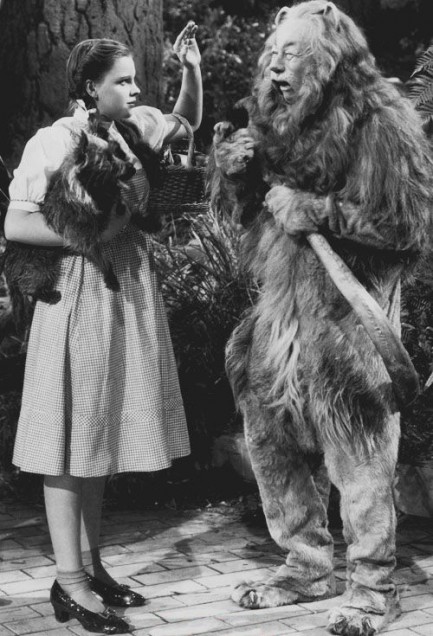 In a classic case of animal abuse. Judy Garland gives cowardly lion Bert Lahr a slap on the nose in The Wizard of Oz. Is it his fault he's a pussy? Accept him as he is, Judy. In a classic case of animal abuse. Judy Garland gives cowardly lion Bert Lahr a slap on the nose in The Wizard of Oz. Is it his fault he's a pussy? Accept him as he is, Judy.
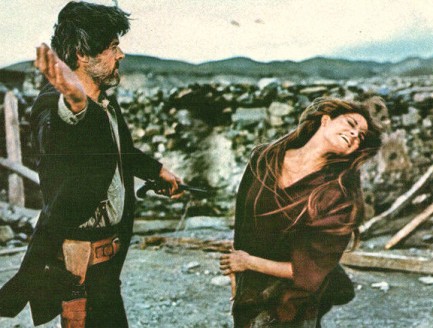 Robert Culp backhands Raquel Welch in 1971's Hannie Caudler. Robert Culp backhands Raquel Welch in 1971's Hannie Caudler.
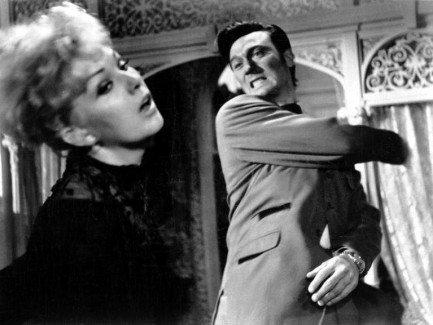 And finally, Laurence Harvey dares to lay hands on the perfect Kim Novak in Of Human Bondage. And finally, Laurence Harvey dares to lay hands on the perfect Kim Novak in Of Human Bondage.
 Welch proves indispensable to yet another ’60s caper flick. 
Above you see a promo poster for 大泥棒, or “Great Thief,” made for the 1968 Raquel Welch/Robert Wagner caper flick The Biggest Bundle of Them All. The U.S. poster was painted by master illustrator Robert McGinnis, but we decided to show you the Japanese art instead because it's rare. There are two more Japanese promos below that are also rare. We'll get to the McGinnis version later. In the film, Wagner and his henchmen kidnap an elderly Italian gangster played by Vittorio De Sica and hold him for ransom. Problem is he has no money. At first they don't believe him, but when it finally becomes clear he's broke, Wagner and Co. try to cut bait. But De Sica is terrified all Italy will find out he couldn't pay his own ransom. His reputation would be ruined. So he convinces his kidnappers to join him in a swindle that will maintain his reputation, make him rich again, and earn the kidnappers more money than they ever imagined. De Sica becomes the boss of his own abductors.
For a crime-comedy, it's an ingenious premise, which makes it a shame it wasn't original. Another movie with an almost identical plot called The Happening was in production at Columbia, and when the studio got wind of The Biggest Bundle of Them All it threatened to sue. Metro-Goldwyn-Mayer agreed to give Columbia a cut of Bundle's profits and a legal bloodbath was avoided, but in the same way De Sica's big caper doesn't exactly play out perfectly, Bundle's profits didn't blow the roof off MGM headquarters as planned. And no wonder. It wasn't just the script that wasn't original—the film falls into the same category as continental crime capers like Charade, To Catch a Thief, and Topkapi, and those make for crowded and treacherous cinematic waters. Bundle isn't sophisticated enough, or exciting enough, or infused with enough sexual chemistry to compete with better films of its ilk.
Speaking of sexual chemistry, Welch is naturally the big attraction of any movie she's in, and we've seen enough of her work now to understand that she was more of a persona than an actress during this mid- to late-’60s period. In film after film she basically played herself. Here she smiles and quips and poses, and it's all very Welchian in that groovy way her fans had come to expect—bikinis, lingerie, go-go dancing and all. The movie would be worth far less without her. There are also supporting appearances by Edward G. Robinson and Femi Benussi, while future blaxploitation icon Godfrey Cambridge is one of the kidnappers, so there's plenty for stargazers to enjoy here, but we can't call the movie a success. If you have nothing to do some evening, it might give you a few smiles, but not a bundle of them. After premiering in the U.S. in 1968, The Biggest Bundle of Them All opened in Japan today in 1968.
 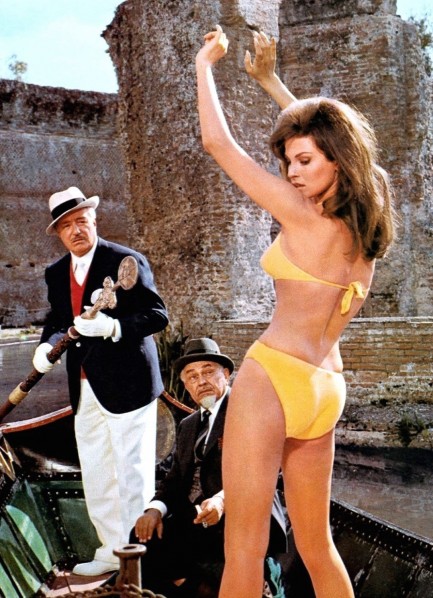 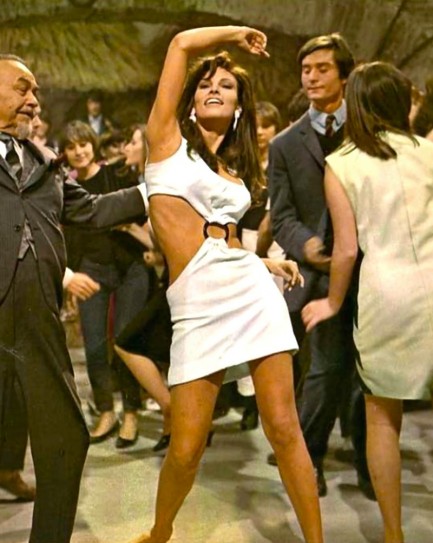 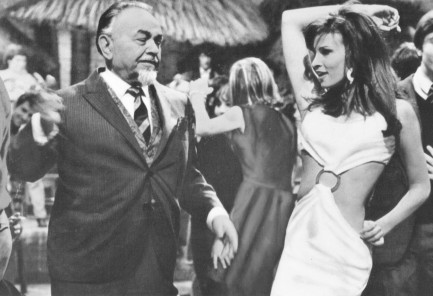 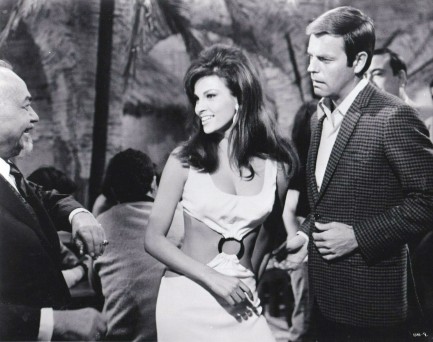 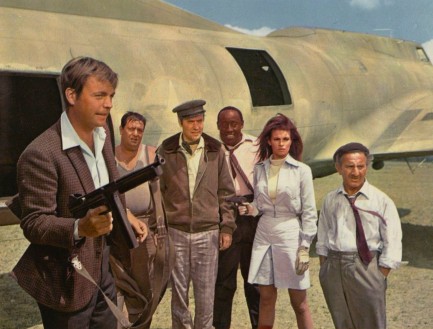 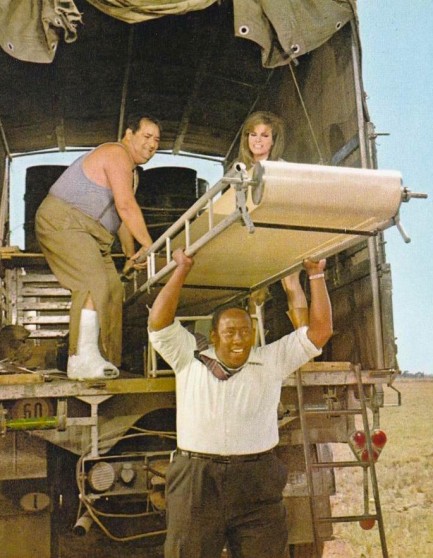 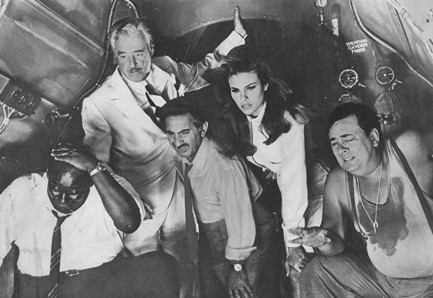  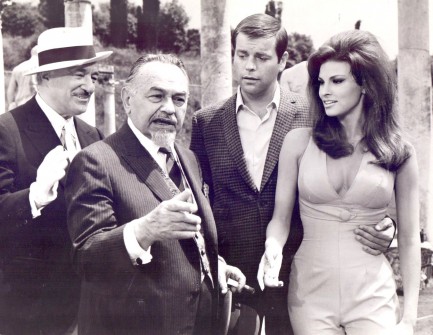 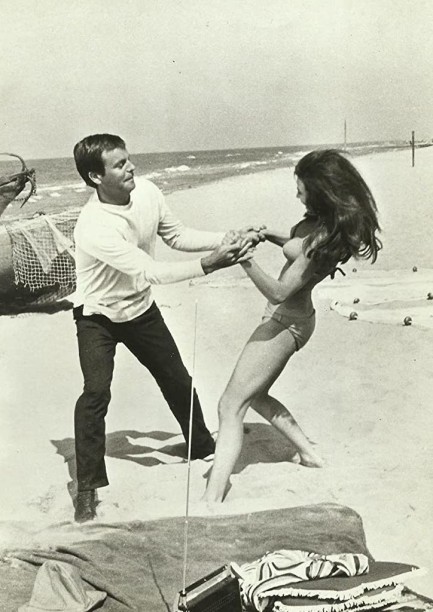 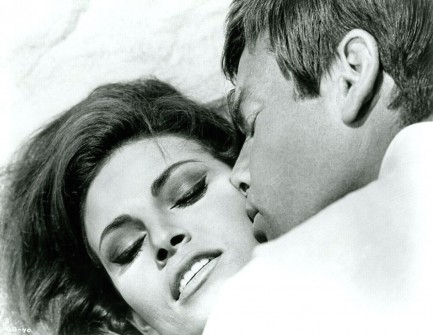      
 To reach your full potential in life you need to stretch yourself. 
Maria Grazia Buccella is a former glamour model, a Miss Italy contestant, and a screen actress with numerous movies to her credit. Some of her appearances include in Le gentleman de Cocody, aka Ivory Coast Adventure, and Vittorio De Sica's Il Boom. The photo above appeared in the Japanese magazine Road Show around 1968.
 She upgraded from broomsticks and black capes a long time ago. 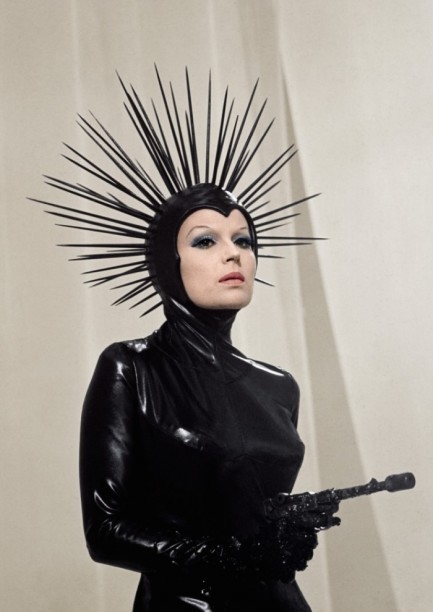
This promo photo was made for the Italian anthology movie Le streghe, aka The Witches, and shows Italian actress Silvana Margano in costume as Giovanna, a bored housewife who imagines herself in elaborate fantasies. This particular fever dream, in the segment called “Una serata come le altre,” or “An Evening Like the Others,” lasts mere seconds, but Margano still makes an impression in her futuristic femme fatale garb. The segment is also memorable because it was directed by Vittorio de Sica and featured Clint Eastwood, but Margano was the star of the movie, appearing in all five witch-related portions as different characters. We may get back to it at some point. This photo is from 1967.
 She doesn't meet the Vatican dress code but she does meet the man of her dreams. 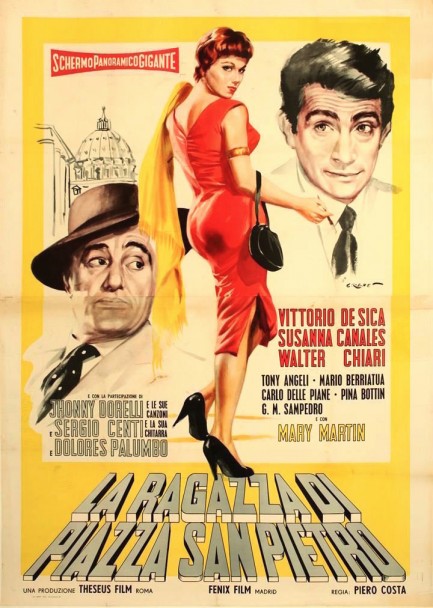 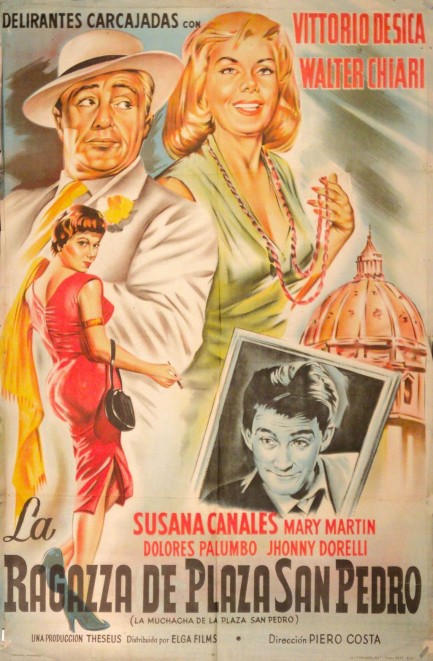
We have two great posters to share today for Piero Costa's La ragazza di piazza San Pietro, aka The Girl of San Pietro Square, starring famed director Vittorio De Sica along with Walter Chiari, Susana Canales, and Mary Martin in the tale of a widower and his three children. The setting is in and around St. Peter's Square in Vatican City, where the main characters are souvenir sellers, and a chance meeting results in romance. The movie is widely available, including on YouTube, but our primary interest is in the art. It has a nice femme fatale look to it. The first poster is signed Crane, and the second, using the same elements, is unsigned but obviously is by the same person. Both are top efforts. We'll dig for more on this Crane character and see what we can find. La ragazza di piazza San Pietro premiered in Italy today in 1958.
 Cut, cut, cut! Wardrobe! Make-up! Somebody! Can't you come up with any way to make her look average? 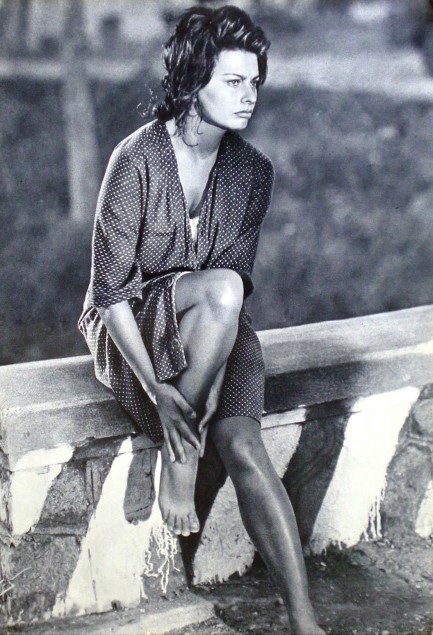
Above, a rather awesome image of Sophia Loren printed from the negative from Vittorio De Sica's 1960 drama La Ciociara, aka Two Women. Even when she looks bad she looks good.
 Tate gives chase in an international fortune hunting comedy about a missing chair. 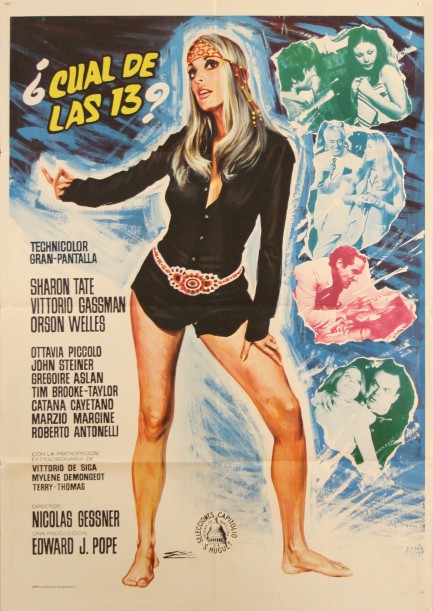
In ¿Las cual de 13?, aka 12 + 1, aka Twelve Plus One, an Italian barber played by Vittorio Gassman inherits thirteen chairs and, deeming them useless, sells them to a London antique shop. He later discovers one of the chairs contains a fortune, but when he returns to the shop he's told they've all been sold. So he offers the antique shop employee Sharon Tate half of the fortune to help him track down the chairs, which of course have scattered to the four winds. Their search takes them to Paris, Rome, and beyond, in 1960s screwball fashion with its expected pratfalls, mix-ups, and sticky situations. Gassman and Tate do reasonable jobs with the goofy script that's been made of Soviet authors Ilf and Petrov's satirical source novel, and the film is boosted by appearances from Vittorio De Sica, Mylène Demongeot, Terry-Thomas, and Orson Welles. This was an Italian production, but the poster above was painted for the film's Spanish run by Carlos Escobar, who signed his work “Esc.” This is the best we've ever seen from a very good artist. Since the movie didn't premiere in Italy until after Tate had been slain this month in 1969, and didn't reach Spain until mid-1970, the poster very likely was painted post-murder, which means Escobar probably was thinking of how to best portray someone who'd become a tragic figure. We suspect he put special effort into his work as a tribute, and if so, a fitting tribute it was. 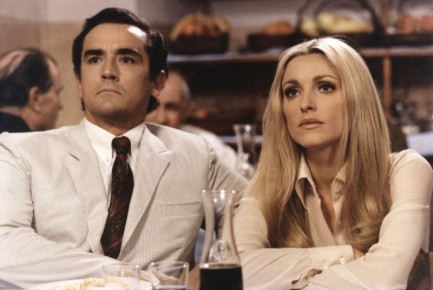 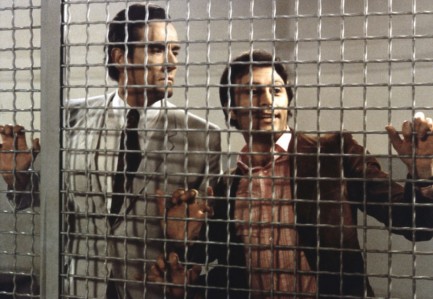  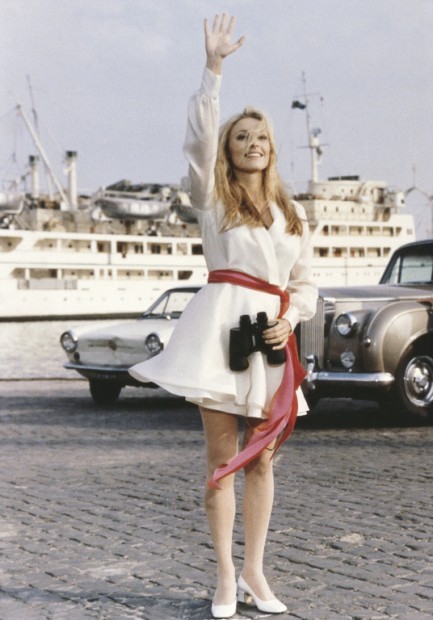
 Holding on for dear life. 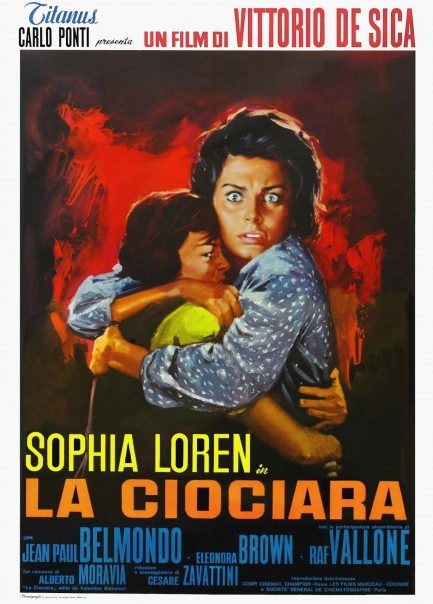
La Ciociara aka Two Women is another film that isn’t pulp or noir, but whose poster art is everything pulp aficionados love. It would fit perfectly on the cover of a Carter Brown book. If you’re a film lover you know director Vittorio de Sica made The Bicycle Thief, which makes this WWII drama based on a novel by Alberto Moravia well worth a screening. Sophia Loren and Jean-Paul Belmondo starred, and it opened today in Italy in 1960.
|
 |

The headlines that mattered yesteryear.
2003—Hope Dies
Film legend Bob Hope dies of pneumonia two months after celebrating his 100th birthday. 1945—Churchill Given the Sack
In spite of admiring Winston Churchill as a great wartime leader, Britons elect
Clement Attlee the nation's new prime minister in a sweeping victory for the Labour Party over the Conservatives. 1952—Evita Peron Dies
Eva Duarte de Peron, aka Evita, wife of the president of the Argentine Republic, dies from cancer at age 33. Evita had brought the working classes into a position of political power never witnessed before, but was hated by the nation's powerful military class. She is lain to rest in Milan, Italy in a secret grave under a nun's name, but is eventually returned to Argentina for reburial beside her husband in 1974. 1943—Mussolini Calls It Quits
Italian dictator Benito Mussolini steps down as head of the armed forces and the government. It soon becomes clear that Il Duce did not relinquish power voluntarily, but was forced to resign after former Fascist colleagues turned against him. He is later installed by Germany as leader of the Italian Social Republic in the north of the country, but is killed by partisans in 1945.
|

|
|

It's easy. We have an uploader that makes it a snap. Use it to submit your art, text, header, and subhead. Your post can be funny, serious, or anything in between, as long as it's vintage pulp. You'll get a byline and experience the fleeting pride of free authorship. We'll edit your post for typos, but the rest is up to you. Click here to give us your best shot.

|
|




 Broderick Crawford slaps Marlene Dietrich in the 1940's Seven Sinners.
Broderick Crawford slaps Marlene Dietrich in the 1940's Seven Sinners. June Allyson lets Joan Collins have it across the kisser in a promo image for The Opposite Sex, 1956.
June Allyson lets Joan Collins have it across the kisser in a promo image for The Opposite Sex, 1956. Speaking of Gilda, here's one of Glenn Ford and Rita Hayworth re-enacting the slap heard round the world. Hayworth gets to slap Ford too, and according to some accounts she loosened two of his teeth. We don't know if that's true, but if you watch the sequence it is indeed quite a blow. 100% real. We looked for a photo of it but had no luck.
Speaking of Gilda, here's one of Glenn Ford and Rita Hayworth re-enacting the slap heard round the world. Hayworth gets to slap Ford too, and according to some accounts she loosened two of his teeth. We don't know if that's true, but if you watch the sequence it is indeed quite a blow. 100% real. We looked for a photo of it but had no luck. Don't mess with box office success. Ford and Hayworth did it again in 1952's Affair in Trinidad.
Don't mess with box office success. Ford and Hayworth did it again in 1952's Affair in Trinidad. All-time film diva Joan Crawford gets in a good shot on Lucy Marlow in 1955's Queen Bee.
All-time film diva Joan Crawford gets in a good shot on Lucy Marlow in 1955's Queen Bee. The answer to the forthcoming question is: She turned into a human monster, that's what. Joan Crawford is now on the receiving end, with Bette Davis issuing the slap in Whatever Happened to Baby Jane? Later Davis kicks Crawford, so the slap is just a warm-up.
The answer to the forthcoming question is: She turned into a human monster, that's what. Joan Crawford is now on the receiving end, with Bette Davis issuing the slap in Whatever Happened to Baby Jane? Later Davis kicks Crawford, so the slap is just a warm-up. Mary Murphy awaits the inevitable from John Payne in 1955's Hell's Island.
Mary Murphy awaits the inevitable from John Payne in 1955's Hell's Island. Romy Schneider slaps Sonia Petrova in 1972's Ludwig.
Romy Schneider slaps Sonia Petrova in 1972's Ludwig. Lauren Bacall lays into Charles Boyer in 1945's Confidential Agent and garnishes the slap with a brilliant snarl.
Lauren Bacall lays into Charles Boyer in 1945's Confidential Agent and garnishes the slap with a brilliant snarl. Iconic bombshell Marilyn Monroe drops a smart bomb on Cary Grant in the 1952 comedy Monkey Business.
Iconic bombshell Marilyn Monroe drops a smart bomb on Cary Grant in the 1952 comedy Monkey Business. This is the most brutal slap of the bunch, we think, from 1969's Patton, as George C. Scott de-helmets an unfortunate soldier played by Tim Considine.
This is the most brutal slap of the bunch, we think, from 1969's Patton, as George C. Scott de-helmets an unfortunate soldier played by Tim Considine. A legendary scene in filmdom is when James Cagney shoves a grapefruit in Mae Clark's face in The Public Enemy. Is it a slap? He does it pretty damn hard, so we think it's close enough. They re-enact that moment here in a promo photo made in 1931.
A legendary scene in filmdom is when James Cagney shoves a grapefruit in Mae Clark's face in The Public Enemy. Is it a slap? He does it pretty damn hard, so we think it's close enough. They re-enact that moment here in a promo photo made in 1931. Sophia Loren gives Jorge Mistral a scenic seaside slap in 1957's Boy on a Dolphin.
Sophia Loren gives Jorge Mistral a scenic seaside slap in 1957's Boy on a Dolphin. Victor Mature fails to live up to his last name as he slaps Lana Turner in 1954's Betrayed.
Victor Mature fails to live up to his last name as he slaps Lana Turner in 1954's Betrayed. Ronald Reagan teaches Angie Dickinson how supply side economics work in 1964's The Killers.
Ronald Reagan teaches Angie Dickinson how supply side economics work in 1964's The Killers. Marie Windsor gets in one against Mary Castle from the guard position in an episode of television's Stories of the Century in 1954. Windsor eventually won this bout with a rear naked choke.
Marie Windsor gets in one against Mary Castle from the guard position in an episode of television's Stories of the Century in 1954. Windsor eventually won this bout with a rear naked choke. It's better to give than receive, but sadly it's Bette Davis's turn, as she takes one from Dennis Morgan in In This Our Life, 1942.
It's better to give than receive, but sadly it's Bette Davis's turn, as she takes one from Dennis Morgan in In This Our Life, 1942. Anthony Perkins and Raf Vallone dance the dance in 1962's Phaedra, with Vallone taking the lead.
Anthony Perkins and Raf Vallone dance the dance in 1962's Phaedra, with Vallone taking the lead. And he thought being inside the ring was hard. Lilli Palmer nails John Garfield with a roundhouse right in the 1947 boxing classic Body and Soul.
And he thought being inside the ring was hard. Lilli Palmer nails John Garfield with a roundhouse right in the 1947 boxing classic Body and Soul. 1960's Il vigile, aka The Mayor, sees Vittorio De Sica rebuked by a member of the electorate Lia Zoppelli. She's more than a voter in this—she's also his wife, so you can be sure he deserved it.
1960's Il vigile, aka The Mayor, sees Vittorio De Sica rebuked by a member of the electorate Lia Zoppelli. She's more than a voter in this—she's also his wife, so you can be sure he deserved it. Brigitte Bardot delivers a not-so-private slap to Dirk Sanders in 1962's Vie privée, aka A Very Private Affair.
Brigitte Bardot delivers a not-so-private slap to Dirk Sanders in 1962's Vie privée, aka A Very Private Affair. In a classic case of animal abuse. Judy Garland gives cowardly lion Bert Lahr a slap on the nose in The Wizard of Oz. Is it his fault he's a pussy? Accept him as he is, Judy.
In a classic case of animal abuse. Judy Garland gives cowardly lion Bert Lahr a slap on the nose in The Wizard of Oz. Is it his fault he's a pussy? Accept him as he is, Judy. Robert Culp backhands Raquel Welch in 1971's Hannie Caudler.
Robert Culp backhands Raquel Welch in 1971's Hannie Caudler. And finally, Laurence Harvey dares to lay hands on the perfect Kim Novak in Of Human Bondage.
And finally, Laurence Harvey dares to lay hands on the perfect Kim Novak in Of Human Bondage. 








































































































